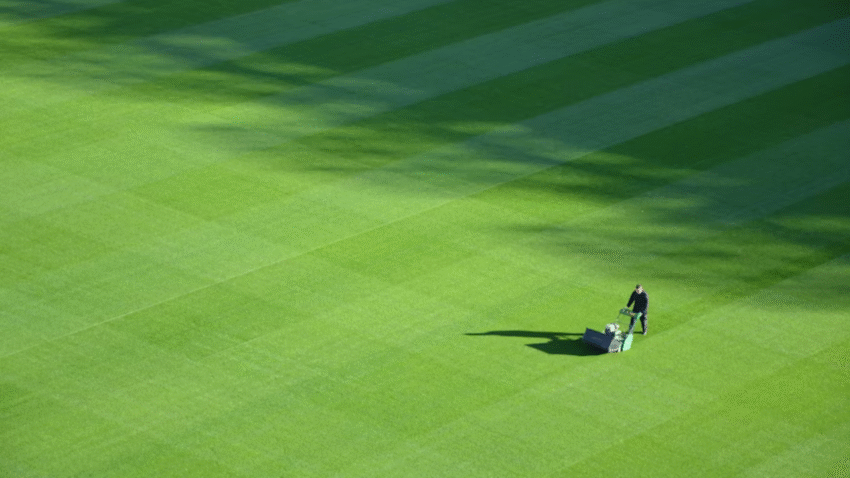Introduction
Did you know your lawn could be costing the environment more than you think? Traditional lawn care methods — gas mowers, excessive watering, synthetic fertilizers — can add up to a surprisingly large carbon footprint. The good news is you don’t have to tear up your yard to make a difference. Learning how to reduce your lawn’s carbon footprint can help you save money, protect natural resources, and create a healthier, more sustainable yard. This step-by-step guide shows you how.
Why Reducing Your Lawn’s Carbon Footprint Matters
Lawns cover millions of acres, and when managed the old-fashioned way, they can waste water, contribute to pollution, and emit greenhouse gases. Gas-powered lawn equipment alone accounts for significant carbon emissions each year. By switching to greener practices, your lawn can become a carbon sink — storing carbon in healthy soil and plants — instead of a carbon source.
A sustainable lawn reduces waste, supports local ecosystems, and can even save you time and money on maintenance.
Step-by-Step Guide to Reducing Your Lawn’s Carbon Footprint
1. Ditch Gas-Powered Lawn Equipment
Gas mowers, leaf blowers, and trimmers are surprisingly polluting. A gas-powered mower can emit as much pollution in an hour as driving a car 100 miles!
✅ Switch to electric or battery-powered equipment: Modern cordless mowers and trimmers are efficient, powerful, and quieter.
✅ Try manual tools: A push reel mower works well for small lawns and requires zero fuel.
Less fossil fuel use = less carbon emissions.
2. Mow Less Often and Mow High
Reducing how often you mow saves energy and supports healthier grass.
✅ Let your grass grow to its ideal height — about 3–4 inches for most turf types. Taller grass shades the soil, reduces water loss, and builds deeper roots.
✅ Skip mowing during droughts or when growth slows naturally.
Fewer mowings means less time, less fuel or electricity, and more carbon stored in your soil and plants.
3. Grasscycle and Mulch Clippings
Instead of bagging clippings, leave them on the lawn to decompose naturally. This process — called grasscycling — returns valuable nutrients and organic matter to the soil, reducing the need for synthetic fertilizers.
✅ Use a mulching mower blade for best results.
✅ Spread excess clippings thinly so they don’t smother the grass.
4. Water Wisely
Overwatering wastes energy to pump, treat, and deliver water — and it can lead to runoff and pollution.
✅ Water deeply and less frequently to encourage drought-tolerant roots.
✅ Water early in the morning to reduce evaporation.
✅ Use smart controllers or rain sensors to prevent unnecessary watering.
Better yet, choose drought-tolerant grass varieties to reduce water needs even more.
5. Use Organic or Slow-Release Fertilizers
Synthetic fertilizers require a lot of energy to produce and can release nitrous oxide — a powerful greenhouse gas — when over-applied.
✅ Test your soil first to see what nutrients you actually need.
✅ Choose organic or slow-release fertilizers that feed soil microbes and improve soil health naturally.
✅ Compost topdressing is an excellent carbon-smart alternative to synthetic fertilizer.
6. Build Healthier Soil
Healthy soil stores more carbon and supports resilient grass.
✅ Aerate your lawn once a year to relieve compaction and improve root growth.
✅ Topdress with a thin layer of finished compost to boost organic matter.
✅ Leave roots in place — every time you mow high and grasscycle, you feed your soil ecosystem.
7. Reduce Lawn Size (If You Want To)
Not ready to get rid of your entire lawn? No problem — just shrink it!
✅ Replace unused or difficult-to-maintain areas with native plants, wildflowers, or ground covers.
✅ Convert sloped sections or shady spots where grass struggles into flower beds, rain gardens, or pollinator patches.
Less turf means less mowing, watering, and fertilizer — all big carbon savers.
8. Plant More Trees and Native Plants
Trees and shrubs store huge amounts of carbon compared to grass alone. Adding native trees and plants around your yard increases shade, reduces irrigation needs, and provides habitat for birds and pollinators.
✅ Plant shade trees strategically to cool your home and lawn, lowering your summer energy use.
✅ Use native perennials that thrive without extra water or fertilizers.
9. Avoid Pesticides and Herbicides
Chemical weed killers and pesticides take energy to produce and can disrupt soil microbes that store carbon naturally.
✅ Practice natural weed management: mow high, overseed thin areas, and pull weeds by hand when possible.
✅ Support beneficial insects like ladybugs and bees that naturally control pests.
Common Mistakes to Avoid
Mistake 1: Bagging Clippings Every Mow
Solution: Grasscycle instead — let clippings decompose to feed your soil.
Mistake 2: Overusing Fertilizer
Solution: Test soil first and choose organic or slow-release options only if needed.
Mistake 3: Watering Too Often
Solution: Water deeply but infrequently to conserve water and strengthen roots.
Mistake 4: Relying on Gas Tools for Small Yards
Solution: For small lawns, try a reel mower or electric equipment instead.
Mistake 5: Keeping Unused Lawn Areas
Solution: Convert problem spots to native plant beds or ground covers that need less care.
Extra Lawn Care Tips & Hacks
✅ Collect Rainwater: Use rain barrels to water your lawn and garden for free.
✅ Try Clover: Clover lawns need less fertilizer and watering than pure turf grass — and they feed pollinators!
✅ Aerate in the Fall: Aeration helps grass roots grow deeper, improving soil structure and carbon storage.
💡 Related read: Check out our guide on [how to overseed your lawn] — a thicker lawn crowds out weeds naturally and reduces the need for chemicals.
Conclusion
Your lawn doesn’t have to be an environmental burden. With a few simple changes — mowing less, ditching gas tools, watering wisely, and boosting soil health — you can dramatically reduce your lawn’s carbon footprint while still enjoying a beautiful, functional yard.
Bookmark this guide and make a plan to green up your lawn care routine — for a healthier yard and a healthier planet.
